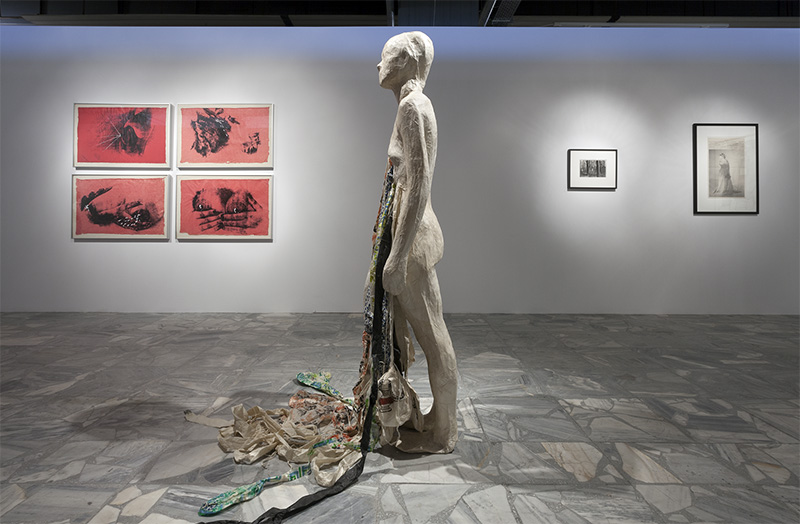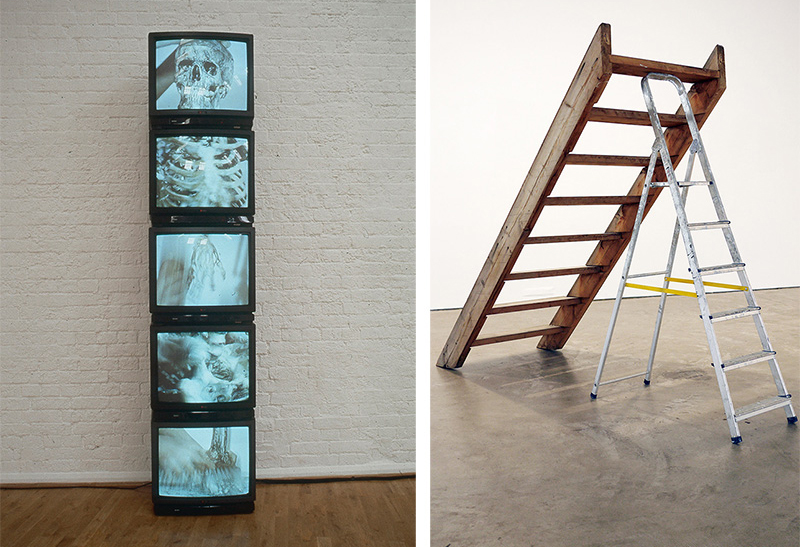ART CITIES:Athens-Flying over the Abyss
 In the group exhibition ”Flying over the Abyss” the artwork of 34 contemporary artists deals with primordial subjects rendered in a contemporary visual discourse, following and drawing inspiration from “The Saviors of God”, a now classic book of Greek literature, a series of “spiritual exercises” written by Greek author Nikos Kazantzakis. Through our magazine we try to guide you around the exhibition with the help of two experienced Curators (Maria Maragkou and Dimitris Palaiocrassas) whose curating is very-very interesting.
In the group exhibition ”Flying over the Abyss” the artwork of 34 contemporary artists deals with primordial subjects rendered in a contemporary visual discourse, following and drawing inspiration from “The Saviors of God”, a now classic book of Greek literature, a series of “spiritual exercises” written by Greek author Nikos Kazantzakis. Through our magazine we try to guide you around the exhibition with the help of two experienced Curators (Maria Maragkou and Dimitris Palaiocrassas) whose curating is very-very interesting.
By Dimitris Lempesis
Photo: NEON Archive
‘’We initially embarked upon a localized issue of and about Crete, while in the process we came to realize the true magnitude of Kazantzakis’ universality as a writer. That being the veracity of his meanings could exist side by side with all articulations of contemporary art’’ Maria Maragkou says. The presentation of ”Flying over the Abyss” at the Athens Conservatoire is the third stop of the exhibition, following its presentation first at the Museum of Contemporary Art of Crete in Rethymnon (2/5-14/10/15) and then at the State Museum of Contemporary Art in Thessaloniki (7/11/15-29/2/16). The exhibition is divided in 5 main sections following the chapters of the book. ‘’All three spawned and shaped different feelings, different demands were advanced. Nonetheless, each one contributed exemplarily to the outcome of this project’’ as Maria Maragkou says. The exhibition includes works by: Marina Abramović, Alexis Akrithakis, Matthew Barney, Hans Bellmer, Lynda Benglis, John Bock, Louise Bourgeois, Heidi Bucher, Vlassis Caniaris, Paul Chan, Savvas Christodoulides, Abraham Cruzvillegas, Stavros Gasparatos, Gilbert & George, Robert Gober, Asta Gröting, Jenny Holzer, Kostas Ioannidis, Mike Kelley, Martin Kippenberger, Giorgos Koumendakis, Sherrie Levine, Stathis Logothetis, Ana Mendieta, Maro Michalakakos, Bruce Nauman, Aliki Palaska, Ioanna Pantazopoulou, Doris Salcedo, Kiki Smith, Paul Thek, Costas Tsoclis, Mark Wallinger anf Gary Webb.

For the selection of the artist and the artworks from D.Dascalopoulos Collection, Dimitris Palaiocrassas says “It’s actually quite easier than one might expect with Kazantzakis leading the way…the power of the ideas in his The Saviors of Gods being so diachronic can be applied to any moment in human history. Also, the structure of his treatise is somewhat chronological in that it follows the path and stations of life. In that sense, a story of human life from birth to death is offered and quickly became the narrative backbone for the exhibition which accordingly divides into 5 Rooms corresponding to the stages of life. Once the themes of the 5 Rooms were determined according to the Kazanantzakis…gospel, it was easy to select the relevant works from the D.Daskalopoulos Collection. It is ofcourse a very loose and personal interpretation of The Saviors of Gods into the visual arts”

In his prologue, Kazantzakis sets the emotional stage of the times “We come from a dark abyss, we end in a dark abyss, and we call the luminous interval life. As soon as we are born the return begins, at once the setting forth and the coming back; we die in every moment. Because of this many have cried out: The goal of life is death!”. The 5-chanel video installation “Cleaning the Mirror #1” (1995) by Marina Abramovic welcomes the viewer. Originally the 1st in a series of 3 performances, “Cleaning the Mirror I” has been transformed into a five-channel video installation. In the performance, Abramovic sits with a skeleton on her lap, next to her a bucket with soapy water. With her right hand, she vigorously brushes the different parts of the skeleton. In the installation, each of the 5 channels is dedicated to one the skeleton’s body parts. By being cleaned, the color of the skeleton becomes lighter, whereas the greyish dirt which once coated the bones starts to cover Abramovic herself. The boundaries between the artist and the ‘object’ acted upon start to blur, the dead and the alive start to intermingle. In a multi-day performance Stathis Logothetis, following the four elements of pro-Socratic philosophers, he buried pieces of fire colored canvas in to the earth, cleaned them in the water of the sea and then dried them by hanging them in the wind. He then wrapped the canvas around his body, sew it and incorporated on stretchers. The resulting “Triptych” (1972) emanates the feeling of a trauma that is partially healed. Kiki Smith’s early work is aligned with the collaborative and activist art scene of the ‘80s, she became known for intimate explorations of the human body in the following decade, often through life-sized sculpture that honored the figural tradition in Western art. These works emphasized the body’s vulnerability and made reference to feminist theories of the “abject,” which conceived of the body as a messy, porous, and boundary-less system. In “Untitled (Pink Bosoms)” (1990-2) by Kiki Smith, the mother’s milk a synonym of live and blood mix together, the two mixing liquids encapsulate the struggle of live. Maro Michalakakos creates works by shaving bits of velvet using a scalpel. After year of collecting the remnants of her works, she used them to create “Oh Les Beaux Jours” (2012), giving them a new life. The result is two mountains of shaved velvet questioning the possibility on not for these elements to join, acting as the archetypal of Male/Female. We were wondering if in D. Daskalopoulos Collection (that encompasses a vast range of contemporary works) there were artworks that the curators would like to encapsulate in the exhibition, but for practical reasons (space), they didn’t and which they were. ‘’Naturally, there are many other artworks which express similar concerns, but choosing has to, in any given instance, satisfy the needs imposed by the space an exhibition is taking place in’’, Maria Maragkou says.

For its presentation in Athens the exhibition is enriched with the new commissioned sound installation “Passage through the Abyss”. Musical themes by Giorgos Koumendakis and Stavros Gasparatos communicate with the sound of the building of the Athens Conservatoire as well as the surrounding areas, underlining and recording the path between the sound of life and the void. “When Elina Kountouri, NEON Director, conceived of the idea of commissioning the sound piece Passage Through the Abyss, we were lucky enough in that the exhibition was still open in Thessaloniki, so we took the “Enallaktiki Lyriki” team for a visit there. They were astutely perceptive in absorbing the feeling of the exhibition and were accordingly creative in their composition and very much in tune with its ambience. Personally, when I listen to the piece I definitely do pick up on the passage of time, the sense of an abyss, a voyage—all very much Kazantzakis. In that sense the sound piece is a parallel sound narrative to the visual arts component”, said Mr. Palaiocrassas. The sound installation communicates with the five stages of being, which forms the backbone of the exhibition, but is placed in an independent sixth space. The spaces of the Athens Conservatoire are wired and recorded so that their endpoints interact with each other as well as with the musical themes. Leaving from this exhibition, that you have the desire to visit it again and again, I was wondering what was the reaction of the viewers in the previous cities, since in Athens with the spiritual dialogue that is created in the imposing spaces of the Conservatory of our desire is insatiable. “The exhibition’s goal is to stimulate emotionally the viewer on the age-old issues of existence, the human condition and the passage of mortal life. Our aim is to awaken feelings and touch the soul of any visitor. As such, the potential audience is absolutely anyone since the exhibition centers around very human issues, life, death and the passage in between. It is not about abstract art historical issues that presuppose specialist knowledge. Our ambition is to impact emotionally anyone even if they have never seen a work of contemporary art ever in their in their lives. On a practical level the voyage through the show is designed towards maximum educational impact: there are informative wall labels for every artwork, trained invigilators in every room available to discuss and the narrative story is made abundantly clear. The response has accordingly been on the same emotional level: the best example is a visitor who upon entering the last room that centers on death, broke into tears”. –Dimitris Palaiockrassas.
Info: Curators: Dimitris Paleocrassas and Maria Maragkou, Athens Conservatoire, 17 Vassileos Georgiou B’ Avenue, Athens, Duration: 18/11/16-29/1/17, Days & Hours: Wed-Fri 12:00-20:00, Sat-Sun 11:00-19:00, http://neon.org.gr

